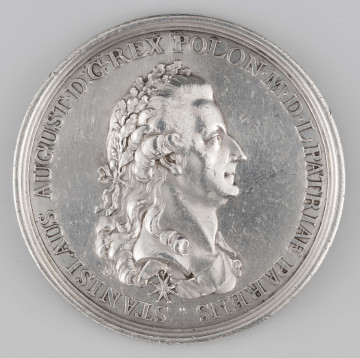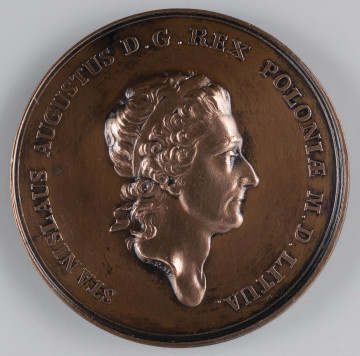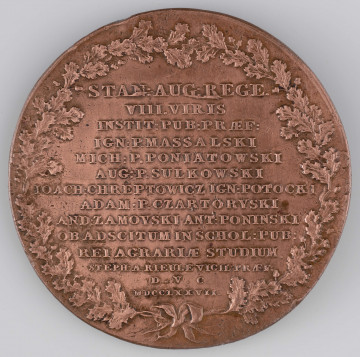
Stanisław August Poniatowski - adoption of the Constitution of 3 May
1791
National Museum in Lublin
Part of the collection: Polish medallic art.
King Stanisław August Poniatowski (1764-1795), an eminent connoisseur, lover and consummate collector, saw in the beauty of art not only a means of elevating the culture of the country, but also an important didactic function in shaping desired social attitudes. A separate role in this respect was played by the medals minted at the Warsaw Mint (1766), among which those of a rewarding character had a special function. This is what the first administrator of the Mint, Antoni Schroeder (ca. 1738-1799), said about them in 1797: ‘As the encouragement and reward of true merit is the basis of royal wisdom, so the monarch soon marked his reign with this, that he distributed gold medals and jettons to those who had distinguished themselves in military service or private life. The King therefore established medals awarded for specific categories of merit: ‘Diligentiae’, ‘Pro fide, grege et lege’, ‘Praemiando incitat’, ‘Virtuti Militari’, ‘Solerti’, ‘Signatum hoc memori’ and the discussed ‘Merentibus’ (‘Meritorious’) established in 1766 and awarded throughout the reign. This distinction was most probably of a universal character. The author was one of the most eminent medallists of the period, Jan Filip Holzhaeusser (1741-1792), associated from 1766 until the end of his life with the king and the mint founded by him.
The medal's obverse is decorated with a representation of the head of Stanisław August taken from the coronation medal of 1766, surrounded by the royal titles. The reverse bears the inscription ‘MERENTIBUS’ and a composition of wreaths: olive, laurel and oak, symbolising wisdom, eternal glory and civic virtue. In 1767, after twelve copies had been struck, the stamp of this medal was damaged. After that year new series were created, among which we can distinguish two types of the obverse and three types of the reverse stamp. They are distinguished by a slightly different representation of the royal head, as well as the inscription and wreaths on the reverse. They were produced in silver and gold in three diameter sizes: 30, 40 and 53 mm. Bronze copies were probably minted later – until the Tsarist authorities exported the stamps to St Petersburg in 1868, after the Warsaw Mint had been closed. This probably includes our medal, struck with the damaged obverse stamp of the first ‘Merentibus’.
Tomasz Markiewicz
Author / creator
Dimensions
cały obiekt: width: 53,3 mm
Object type
medal
Technique
stamp minting
Material
copper
Creation time / dating
Creation / finding place
Owner
The National Museum in Lublin
Identification number
Location / status

1791
National Museum in Lublin

1790
National Museum in Lublin

1777
National Museum in Lublin
DISCOVER this TOPIC
National Museum in Szczecin
DISCOVER this PATH
Educational path